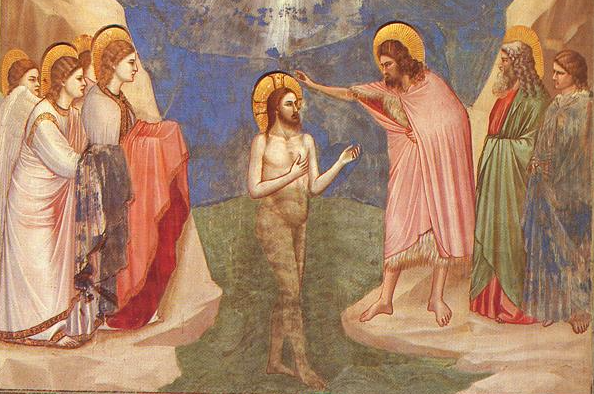The beginning of the gospel of Jesus the Messiah (Ἰησοῦ Χριστοῦ), the son of God (υἱοῦ θεοῦ). 2 As it is written in Isaiah the prophet, “Behold, I send my messenger before thy face, who shall prepare thy way; 3 the voice of one crying in the wilderness: Prepare the way of the Lord, make his paths straight—” 4 John the baptizer appeared in the wilderness, preaching an immersion of repentance for the forgiveness of sins (βάπτισμα μετανοίας εἰς ἄφεσιν ἁμαρτιῶν). 5 And there went out to him all the country of Judea, and all the people of Jerusalem; and they were baptized by him in the river Jordan, confessing their sins. 6 Now John was clothed with camel’s hair, and had a leather girdle around his waist, and ate locusts and wild honey. 7 And he preached, saying, “After me comes he who is mightier than I, the thong of whose sandals I am not worthy to stoop down and untie. 8 I have baptized you with water; but he will baptize you with the Holy Spirit (ἐν πνεύματι ἁγίῳ).” 9 In those days Jesus came from Nazareth of Galilee and was baptized by John in the Jordan. 10 And when he came up out of the water, immediately he saw the heavens opened and the Spirit descending upon him like a dove (ὡς περιστερὰν); 11 and a voice came from heaven, “Thou art my beloved son (ὁ υἱός μου ὁ ἀγαπητός); with thee I am well pleased.” (Mark 1:1-11; adapted from RSV)
Mark’s programmatic opening of the Gospel narrative also appears in a slightly reworked and expanded form in Matthew 3:1-17 and Luke 3:2-22.
Premium Members and Friends of JP must be signed in to view this content.
If you are not a Premium Member or Friend, please consider registering. Prices start at $5/month if paid annually, with other options for monthly and quarterly and more: Sign Up For Premium
- [1] See Marcus, Mark 1-8: A New Translation with Introduction and Commentary (New York: Doubleday, 2005), 40-56. ↩
- [2] See William D. Davies and Dale C. Allison, A Critical and Exegetical Commentary on the Gospel according to Saint Matthew (3 vols.; Edinburgh: T. & T Clark, 1988-1997), 1:286, 323-343; Joseph Fitzmyer, The Gospel according to Luke, Anchor Bible (Garden City, N.Y.: Doubleday, 1981), 479-487. See also Marcus, Mark 1-8, 138-140. ↩
- [3] On the sources of Mark, see, for example, Christopher S. Mann, Mark, Anchor Bible (Garden City, New York: Doubleday, 1986), 16-19. For this periscope, see Markus, Mark 1-8, 138-139. See also David Flusser, Jesus (Jerusalem: Magnes, 2001), 37-55. ↩
- [4] In the large volume dedicated to the messianic theme, James H. Charlesworth (ed.), The Messiah: Developments in Earliest Judaism and Christianity (Minneapolis: Fortress Press, 1992) there is only one contribution dealing with Jewish Hellenistic thought (Peder Borgen’s “‘There Shall Come Forth a Man:’ Reflections on Messianic Ideas in Philo”). ↩
- [5] See Flusser, Jesus, 47-53. ↩
- [6]
Then Jesus came from Galilee to the Jordan to John, to be baptized by him. John would have prevented him, saying, “I need to be baptized by you, and do you come to me?” But Jesus answered him, “Let it be so now; for thus it is fitting for us to fulfill all righteousness.” Then he consented. (Matt. 3:13-15)
Cf. the treatment of the hierarchy between the Baptizer and Jesus in Luke 1-2 and John 1:19-34. ↩ - [7] Cf. the description of the Baptizer in Josephus, Ant. 18:118-119. ↩
- [8] See David Flusser, “John’s Baptism and the Sect of the Judean Desert,” in idem, Jewish Sources in Early Christianity: Studies and Essays (Tel Aviv: Sifriyat Poalim, 1979), 81-112 (in Hebrew); Étienne Nodet and Justin Taylor, The Origins of Christianity: An Exploration (Collegeville, Minnesota: The Liturgical Press, 1998), 57-88; Justin Taylor, Pythagoreans and Essenes: Structural Parallels (Paris: Peeters, 2004), 19-20; Thomas Joseph, Le movement baptiste en Palestine et Syrie (150 av. J.-C.-300 ap. J.-C) (Piscataway, NJ: Gorgias Press, 2010). ↩
- [9]
But when he saw many of the Pharisees and Sadducees coming for baptism, he said to them, “You brood of vipers! Who warned you to flee from the wrath to come? Bear fruit that befits repentance.” (Matt. 3:7-8)
Cf. Luke 3:7-9, where it is not the Pharisees and Sadducees but the general crowd who are the object of John’s invective. ↩ - [10] See, for example, Flusser, Jesus, 37-40; Frédéric Manns, L'Evangile de Jean a la lumiere de Judaisme (Jerusalem: Franciscan Printing Press, 1991). For a different appraisal, see Joan E. Taylor, The Immerser: John the Baptist within Second Temple Judaism (Grand Rapids, Mich.: Eerdmans, 1997). Cf. Hartmut Stegemann, The Library of Qumran, on the Essenes, Qumran, John the Baptist, and Jesus (Grand Rapids, Mich.: Eerdmans, 1998). For a discussion of the variety of existing scholarly opinions regarding the measure of overlap between Qumran and John's immersions, see Leonard F. Badia, The Qumran Baptism and John the Baptist’s Baptism (Lanham, Md.: University Press of America, 1980). ↩
- [11] F. García Martínez and E. J. C. Tigchelaar (eds.), The Dead Sea Scrolls Study Edition (Leiden: Brill, 1999). ↩
- [12] For the closeness of the Baptizer’s eschatological outlook to that of the Dead Sea Scrolls, see Flusser, Jesus, 258-275. ↩
- [13] Some scholars have therefore suggested seeing John as a “marginal Essene.” See David Flusser, Jesus, 37-38. ↩
- [14] See, for example, Serge Ruzer, “Nascent Christianity between Sectarian and Broader Judaism: Lessons from the Dead Sea Scrolls,” in Adolfo Roitman, Laurence H. Schiffman and Shani Tzoref (eds.), The Dead Sea Scroll and Contemporary Culture (Leiden: Brill, 2010), 477-493. For a former assessment, see Moshe Navon, Messianic Figures in Second Temple Judaism: Relationship between the Charismatic Leader and His Adherents (Pd.D. diss.; The Hebrew University of Jerusalem, 2004) (in Hebrew). ↩
- [15] See, for example, b. Ber. 3a; b. Sanh. 97b; 98a. ↩
- [16] See Serge Ruzer, “Son of God as Son of David: Luke’s Attempt to Biblicize a Problematic Notion,” in L. Kogan, N. Koslova, S. Loesov and S. Tishchenko (eds.), Bibel und Babel 3 (Winona Lake: Eisenbrauns, 2007), 321-352. ↩
- [17] See Shemaryahu Talmon, “The Concepts of MASIAH and Messianism in Early Judaism,” in James Charlseworth (ed.), The Messiah: Developments in Earliest Judaism and Christianity (Minneapolis: Fortress Press, 1992), 79-115. The reasons for that upsurge might have been varied and cannot be discussed here. ↩
- [18] For messianic ideas reflected in the Dead Sea Scrolls, see Lawrence Schiffman, “Messianic Figures and Ideas in the Qumran Scrolls,” in The Messiah; Developments in Earliest Judaism and Christianity, 116-129; John J. Collins, The Scepter and the Star; The Messiahs of the Dead Sea Scrolls and Other Ancient Literature (New York: Doubleday, 1995), 75-77. See also David Flusser, “Jewish Messianism Reflected in the Early Church”; Ruzer, Mapping the New Testament, 101-129. ↩
- [19] See Flusser, Jesus, 42, 113-123. ↩
- [20] See Marcus, Mark 1-8, 160; cf. the programmatic opening of Paul’s Epistle to the Romans (1:1-4). ↩
- [21] “I will tell of the decree of the LORD: He said to me, ‘You are my son, today I have begotten you’” (Ps. 2:7). See, for example, the Nestle-Aland edition of the Greek-English New Testament (8th rev. ed.; Stuttgart: Deutsche Bibelgesellschaft, 1994), 6, 162, 783; Mann, Mark, 199; Marcus, Mark 1-8, 162. See also discussion in Ruzer, “Son of God as Son of David.” ↩
- [22] See note 18 above. ↩
- [23] Flusser (Jesus, 42) suggests—in an attempt at unearthing the historical kernel of the episode—that “the endowment with the Holy Spirit, accompanied by an ecstatic experience, was apparently something which happened to others who were baptized in John’s presence in the Jordan.” ↩
- [24] Cf. the (mis-)interpretation in Luke 3:22: σωματικῷ εἴδει ὡς περιστερὰν (“in bodily form, as a dove”). ↩
- [25] See Jacob Neusner, “The Theory of History of Genesis Rabbah,” in Jacob Neusner and Alan J. Avery-Peck (eds.), The Christian and Judaic Invention of History (Atlanta, Ga.: Scholars Press, 1990), 209; Burton H. Visotsky, “Genesis in Rabbinic Interpretation,” in Craig A. Evans, Joel N. Lohr and David L. Petersen (eds.), The Book of Genesis: Composition, Reception, and Interpretation (Leiden: Brill, 2012), 579 and note 3 there. For conflicting appraisals of Genesis Rabbah’s literary genesis, see Hans-Jürgen Becker, Die grossen rabbinischen Sammelwerke Palästinas; zur literarischen Genese von Talmud Yerushalmi und Midrash Bereshit Rabba (Tübingen: Mohr Siebeck, 1999); Chaim Milikowsky, “On the Formation and Transition of Bereshit Rabbah and the Yerushalmi: Questions of Redaction, Text-Criticism and Literary Relationships,” Jewish Quarterly Review 92.3-4 (2002): 521-567. ↩
- [26] See, for example, Hans-Jürgen Becker, “Matthew, the Rabbis and Billerbeck on the Kingdom of Heaven,” in Hans-Jürgen Becker and Serge Ruzer (eds.), The Sermon on the Mount and Its Jewish Setting (Paris: Gabalda, 2005), 57-69. See also Reimund Bieringer, Florentino García Martínez and Peter Tomson (eds.), The New Testament and Rabbinic Literature (Leiden and Boston: Brill, 2010). ↩
- [27] Cf. Visotsky, “Genesis in Rabbinic Interpretation,” 585-586; Zvi Ron, “The Book of Jubilees and the Midrash on the Early Chapters of Genesis,” Jewish Biblical Quarterly 41.3 (2013): 143-155. ↩
- [28] Jacob Neusner, “Genesis Rabbah, Theology of,” in Jacob Neusner and J. Avery-Peck (eds.), Encyclopaedia of Midrash I: Biblical Interpretation in Formative Judaism (Leiden: Brill, 2005), 108. ↩
- [29] See Hyam Maccoby, “Ben Zoma’s Trance,” Journal of Progressive Judaism 1 (1993): 103-108. This is not the only instance where the rabbinic tradition ascribes (an understandable) puzzlement regarding details of the creation account to Ben Zoma; see Aron Pinker, “Ben Zoma’s Query on Genesis 1:7: Was It What Drove Him Insane?” Judaism 55.3-4 (2006): 51-58. ↩
- [30] Jacob Neusner, Judaism and the Interpretation of Scripture: Introduction to the Rabbinic Midrash (Peabody, Mass.: Hendrickson, 2004), 30-31; idem, “Genesis Rabbah, Theology of,” 110; Visotzky, “Genesis in Rabbinic Interpretation,” 579-591. Cf. Howard A. David, Polemics and Mythology: A Commentary on Chapters 1 & 8 of Bereshit Rabbah (1992), 150, who argues that polemics may have been directed toward a Jewish audience that held ideas overlapping with those of “outsiders.” ↩
- [31] Some discern it in Gen. Rab. 1:4 in the claim that, actually, not only the Torah, but also Patriarchs, Israel and the Temple were present in God’s contemplation before the Creation and thus belong to the unchangeable matrix of sacred history. Even the appearance in this context of the motif of the Messiah’s name has been interpreted—with reference to a more detailed elaboration in b. Sanh. 98b—as polemically propagating a Messiah whose name would be not Jesus. See David, ibid. ↩
- [32] But cf. Marcus, Mark 1-8, 163-167, where the scene of Jesus’ baptism is contextualized almost exclusively vis-à-vis Old Testament prophetic sayings. ↩



